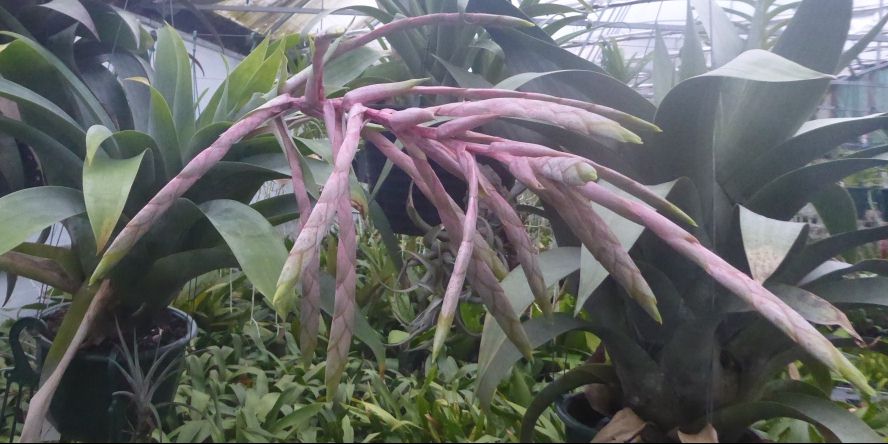
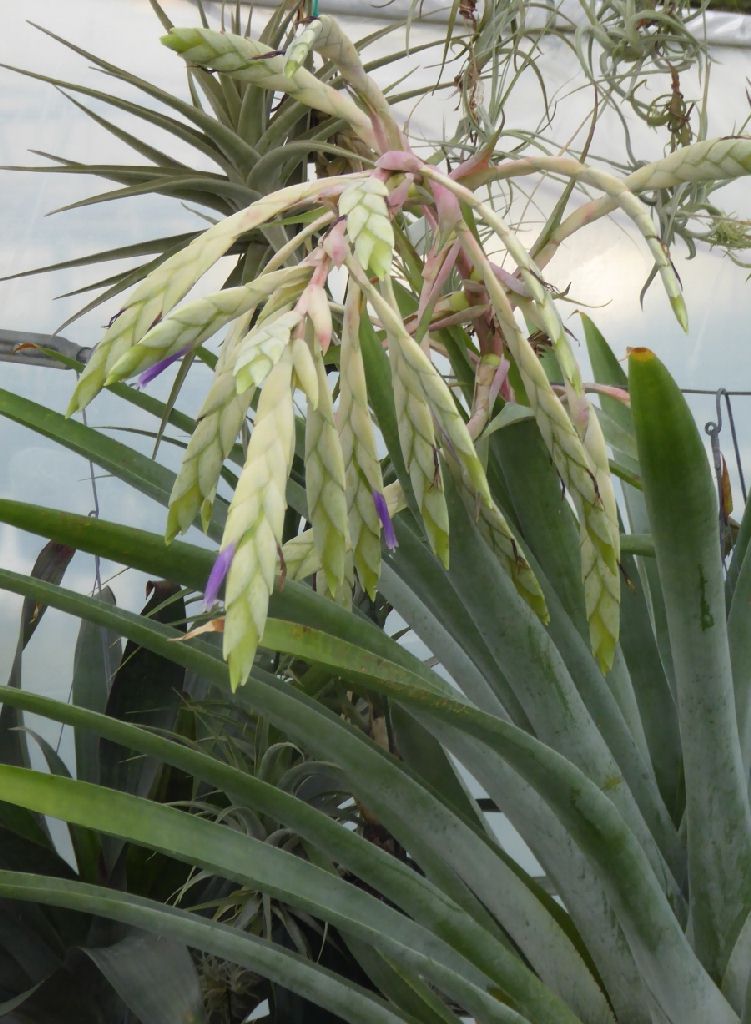
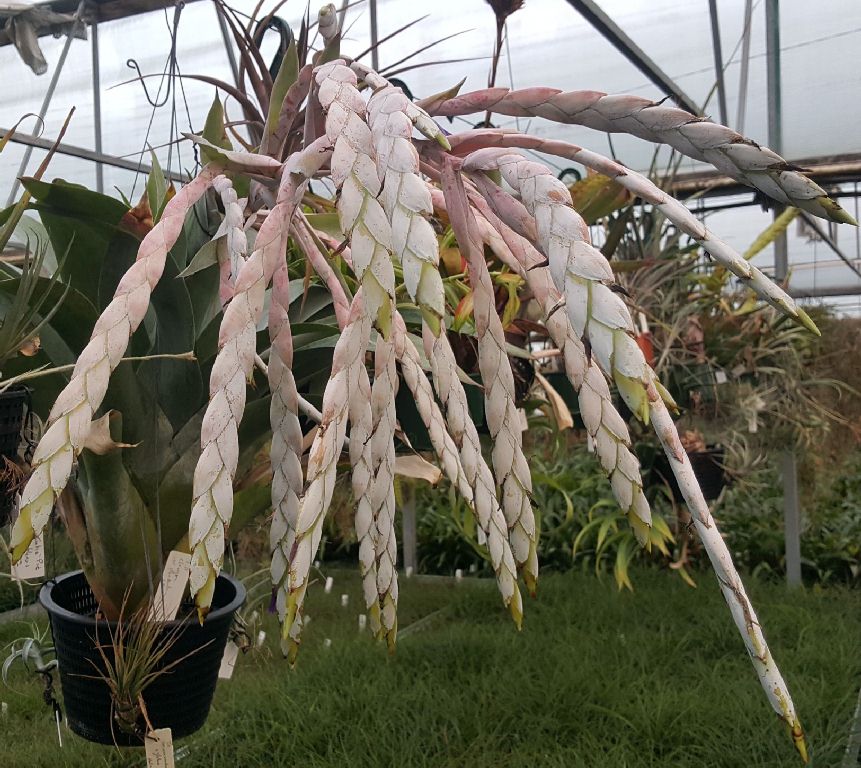
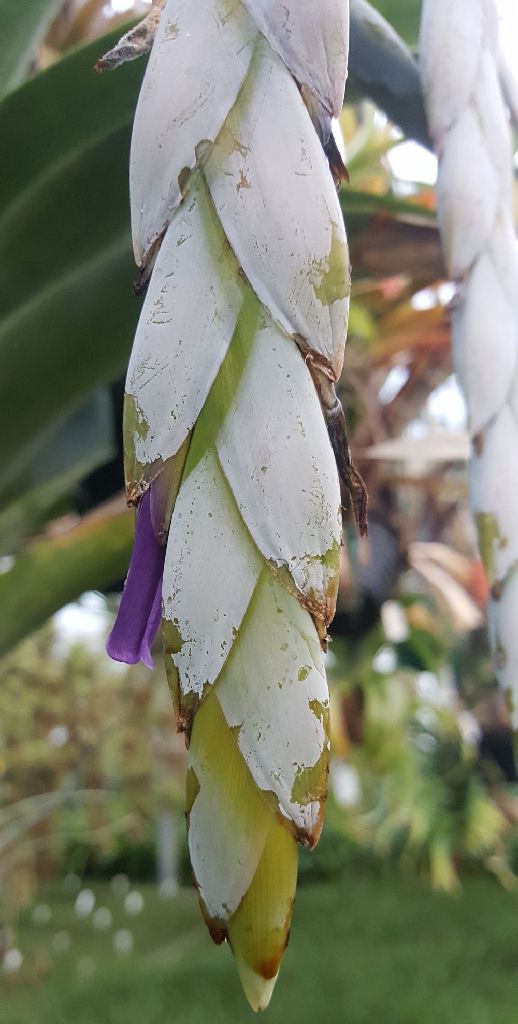
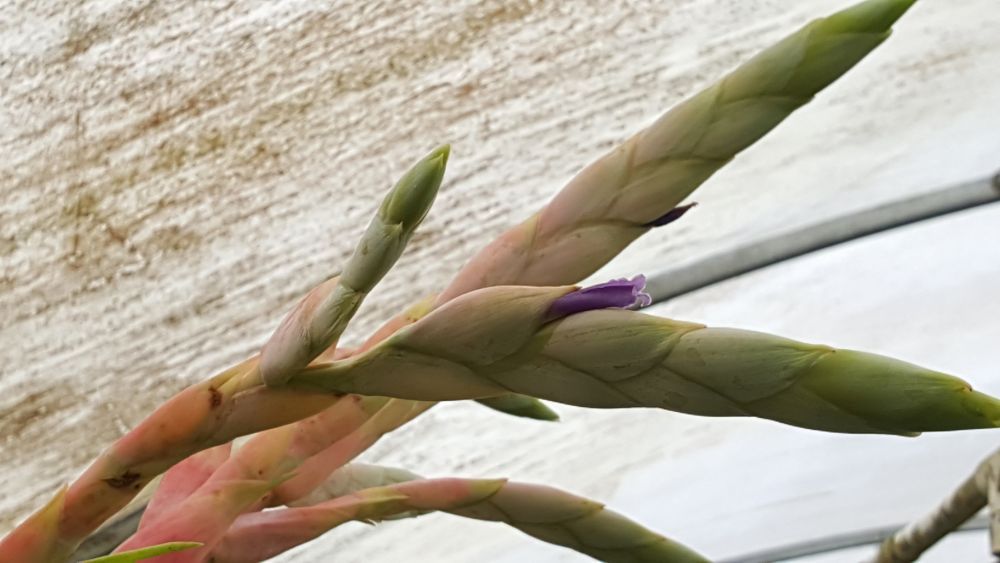
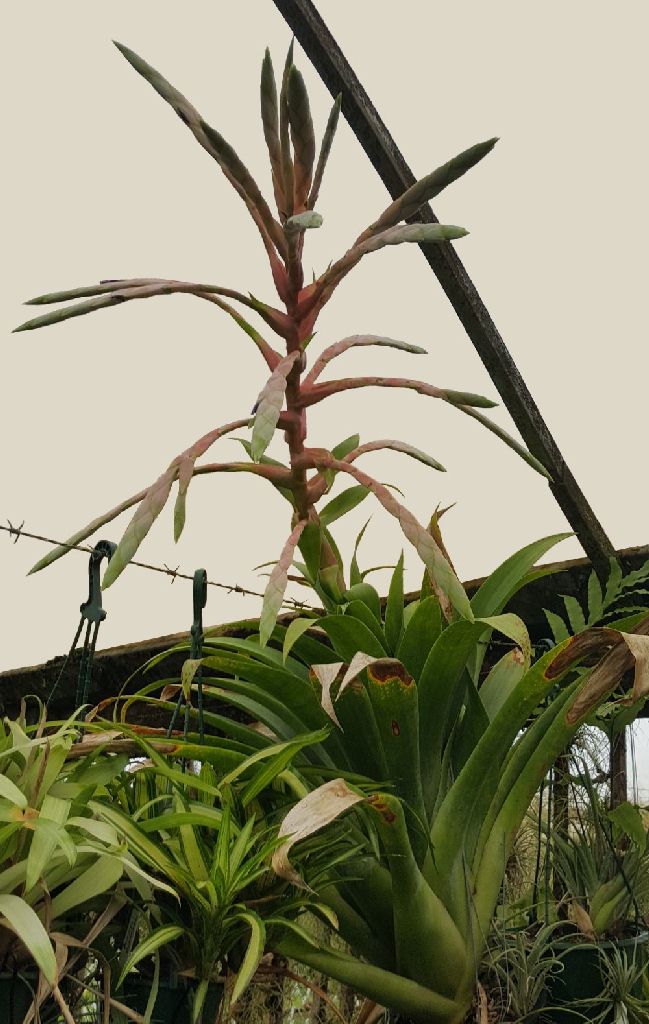
Desc from S&D p711 and Trop Subtrop Pflanzen 52:59-62. 1985
Plant stemless, flowering 2 m high.
Leaves 40-85 cm long;
Sheaths ovate, distinct, 20 cm long, brown;
Blades ligulate, acuminate, 6-9 cm wide, very obscurely punctulate-¬lepidote.
Scape erect, stout;
Scape-bracts foliaceous, densely imbricate.
InfIorescence laxly bipinnate, glabrous;
Primary bracts exceeding the long sterile bracteate bases of the lower spikes but shorter than those of the upper ones;
Spikes reflexed, linear, complanate, to 55 cm long, 3 cm wide.
Floral bracts broadly obovate, acute, 30-35 mm long, broadly convex, carinate at apex, coriaceous, even;
Flowers subsessile.
Sepals oblong, acute, 28-30 mm long, coriaceous, free, the posterior carinate. (from Rauh –reddish, topside scattered appressed small lepidote, soon glabrous)
Petals (From Rauh – narrow-lanceolate, to 5.5cm long, 5mm wide, blue/violet, white toward the base.)
Stamens & Style (From Rauh - enclosed, a little shorter than petals)
Capsule shorter than the sepals.
Tillandsia clavigera var. clavigera
Tillandsia deppeana var clavigera (Mez) L. B. Smith, Phytologia 5: 395. 1956.
Inflorescence erect, but spikes abundantly bent downwards,
All organs glabrous, hardly frosted
Type. Stubel 208-A (holotype B, GH photo), near Quito, Pichincha, Ecuador, Sep 1871.
DISTRIBUTION. Epiphytic in forest, 750-3000 m alt, Colombia, Ecuador.
COLOMBIA. MAGDALENA: Chinchicua, Sierra Nevada de Santa Marta, Aug 1946, Foster & Smith 1473 (GH, US). CUNDINAMARCA: El Chico, Bogota, 11 Oct 1946, Foster 1844 (COL, GH, US); Guaduas, 22 Jul 1965, King & Guevara 6028 (COL, F, US). ECUADOR. LOJA: Porto Velo, Cachicaran, 30 Nov 1948, Foster 2602 (F, US). NAPO: Borja, Cerro Antisana, 15 Aug 1960, Grubb et al 1285 (OXF, US). PERU: HUANUCO: Rio Llulla Pichis watershed, Cerros del Sira, 9.30 S, 74.47 W, 9 Ju11969, Wolfe 12287 (NA, US).
From Gilmartin in Phytologia 16: 157. 1968
NOTES: The differences evident between T. clavigera Mez and T. fendleri Griseb, seem sufficient to set these two apart at the species level.
(fendleri, according to Smith, 1965, Bromel . Soc. Bull . 15 (1) :4, is the correct epithet for south American specimens which had been placed in T. deppeana.)
The floral bracts of T. clavigera do not exceed 3.5 cm in length, the sepals are not more than 3.0 cm long and the stipe is consistently longer than 1.0 cm and may be up to 15 cm long.
Tillandsia clavigera var pendula Rauh
Inflorescence bent downwards, bipinnate, to 80 cm long.
Spikes hanging, to 20cm long, 3cm wide
All Organs, with the exception of petals and sepals, with a thick chalky white surface, while these have no wax it appears more a flavonoid.
Holotype Rauh 63 924 (17/8/1983) in HEID
Habitat and Range Central Peru, in the valley of Yaupi-Baja, Dept. Cerro de Pasco, about 2400m. alt, on steep rocks with T. fendleri Griseb. var. fendleri
Detail from Trop Subtrop. Pflanz. 52:59-62. 1985
Tillandsia clavigera var. pendula Rauh var. nov.
A typo T. clavigera differt inflorescentiis pendulis, bracteis floralibus longioribus, sepalis longioribus et pruina intense alba organum omnium sepalis petalisque exceptis.
Holotypus : Rauh 63 924 (in spiritu alcoholico conservatur), in herb. inst. bot. system. univ. heidelb. (HEID).
Habitat et distributio : Peruvia centralis, in valle Yaupi-Baja, Dptm. Cerro de Pasco apud 2400 m.s.m. in parietibus rupium arduis una cum T. fendlero Griseb. var. fendlero.
Differs from the type T. clavigera Mez by the hanging inflorescence, the long floral bracts, the long sepals and by the strong white frosting on all organs, sepals and petals excluded.
Habitat and range: central-Peru, in the valley of Yaupi-Baja, Dptm. Cerro de Pasco, 2400 m, at steep rocks, with T. fendleri Griseb. var. fendleri.
Plant stemless, in age with short, thick, rhizome covered by old leaf bases and a hanging inflorescence (fig. 36, right).
Leaves numerous, forming an erect, to 80 (-100) cm high and 60-80 cm wide funnel rosette.
Sheaths very large, long, to 15 cm long and 10 cm wide, dark brown lepidote, indistinct.
Blade to 70 cm long, 10-15 cm wide, ligulate, tapering to a short tip, glabrous, white frosted, yellowish green, somewhat red flecked, at the tip from time to time wine-red.
Scape thick, bent, shorter than the rosette, covered by subfoliate scape bracts.
Inflorescence hanging, bipinnate, to 80 cm long, ~20 cm wide, with 10-15 hanging spikes(fig. 36, right).
Inflorescence axis bent downwards, 1 cm thick, angular, green-reddish, wwhite frosted.
Primary bracts as long as or shorter than the sterile section of the spike, almost enveloping these, long-lanceolate, acuminate, to 10 cm long, green to reddish, white frosted.
Spikes hanging,(fig. 36) short, (0.5 cm) and thick stemmed, to 20 cm long, 3 cm wide, complanate, the basal ones with 10 cm long, leafed, sterile section.
Peduncle bracts very large – 2 keeled, adaxial.
Flowers distichous, erect, up to 12.
Rhachis glabrous, white frosted, somewhat visible only postfloral.
Floral bracts erect, at the base 2 keeled, flattened, at the tip indistinctly keeled, longish egg shaped, 4-5 cm long, 2 cm wide, (extended), acuminate, strong, carmine red violet and underneath thick white frosting, therefore appearing grey, upperside scattered appressed small brown lepidote as long as the sepals.
Flowers thick and short stemmed, to 6 cm long.
Sepals long lanceolate, to 3,7 cm long, 1 cm wide, the posterior pair sharp keeled, free, reddish, upperside scattered appressed small lepidote, otherwise glabrous.
Petals narrow lanceolate, to 5.5 cm long, 5 mm wide, blue-violet, white towards the base.
Stamens and style enclosed, a little shorter than the petals.
Holotype: Rauh 63 924, 17. 8. 1983, in the, HEID.
Habitat and range: valley of Yaupi-Baja (Dptm). Cerro de Pasco, 2400 m, on steep rocks, with T. fendleri Griseb. var. fendleri.
Tillandsia brevicapsula Gilmartin, Phytologia 16: 156. 1968.
A T. denudata Andre, cui affinis, ramis ad 30 cm longis, capsulis brevioribus, differt. (Treated as a synonym of T. clavigera in Binomials #9 2004 No reason given.)
Desc from S&D p711
Plant probably flowering over 1 m high.
Leaves (only one known) 46 cm long;
Sheaths elliptic, 20 cm long, 9 cm wide;
Blades ligulate, acuminate, 55 mm wide, obscurely punctulate-lepidote on both sides.
Inflorescence probably over 5 dm long, laxly bipinnate, glabrous;
Primary bracts ovate, attenuate, 8 cm long, much shorter than the sterile bracteate bases of the branches;
Spikes pendent, linear, complanate, 20 cm long, ca 25 mm wide, densely many-flowered;
Rhachis flexuous, narrowly alate.
Floral bracts imbricate and undoubtedly concealing the rhachis at anthesis, broadly elliptic, obtuse or apiculate, 24 mm long, broadly convex, carinate, coriaceous, even;
Flowers subsessile.
Sepals ovate-elliptic, obtuse, 20 mm long, 8 mm wide, free, faintly nerved, the posterior carinate;
Petals 35 mm long.
Capsule equaling the sepals.
Type. Firmin 652 (holotype US, isotype F), without exact locality, 2700 m alt (?), Pichincha, Ecuador, 3 Jan 1929.
DISTRIBUTION. Terrestrial among bushes, 2200-2700 (?) m alt, Ecuador, Peru.
PERU. CAJAMARCA. Chota: Ruambos. 23 Aug 1970, Rauh 24242 (HEID. US).
Protologue
Tillandsia clavigera Mez, DC. Monogr. Phan. 9: 783. 1896.
140. T. clavigera; inflorescentia laxe basi tri-, apicem versus bipinnatim panniculata; spicis axi primario pinnatim insertis, nutantibus, flabellatis, ~8-floris, bractees primarias longe superantibus; bracteolis florigeris sepala subaequantibus; floribus ercctis; sepalis aequaliter liberis; petalis stamina superantibus.
Epiphyta, maxima (ex cl. Stubel !), foliis scapoque ignotis. Inflorescentia multiflora, laxa, e ramulis dependentibus usque ad 0.2 m. longis, medium usque sterilibus prophyllis compluribus imbricates indutis composita, validissima, certe ultra 0.4 m. longa; axibus glabris, subangulatis, pulchre rubentibus; spicis paullo solum complanatis, clavatim in stipites transeuntibus, ad 80 mm. longis, 18 mm. latis; bracteis primariis absque dubio saturate purpureis, crasse coriaceis, ovato-triangularibus, reflexo-patentibus, inferioribus maximis quidem sed tamen quam ramuli axillares brevioribus; bracteolis florigeris erectis, dense imbricatim sibi incumbentibus, rigide coriaceis, dorso glabris laevissimisque nitidis, linea media longe ultra medium impressis apicem versus obscure solum vel vix carinatis, latissime ovato-ellipticis apiceque egregie rotundatis, ~30 mm. longis, 20 mm. latis. Flores pedicellis brevissimis percrassisque, angulatis stipitati, ad 34 mm. longi; sepalis crasse coriaceis. carinatis, dorso glabris sublaevibusque intus dense lepidoto-punctulatis, late ovalis, apice (explanatis) rotundatis, ~25 mm. longis, 12 mm. latis. Petala sepalis ad 8 mm. longiora, late lingulata, apice rotundata, per anthesin suberecta. Ovarium crasse prismaticum, ovulis longe caudatis.
Ecuador, prope Quito in Cerro Ilalo, alt. 3000 m. : Stubel n. 208a, - Floret Septembri. (V. s. in herb. Hieron, nunc Berol.)
Differs from T. clavigera
Plant much smaller
Spike to 17cm long compared to 55cm
Floral bracts longer (4.2cm) unkeeled and waxy covered compared to 3.0-3.5cm unkeeled and keeled at tip
Sepals not oblong rather lanceolate
Hi Eric/UD: I remember the article, Eric, but thought 'Venezuela – forget it' and did. Did you get the species Loma posted from Knize? The plant was in Pam Butler's collection in Queensland, so Loma told me. I am sure both you and Peter Bak would have it. I think I still have some in bloom too. Did you see it in Peru?
From: Eric Gouda. To: Pater Tristram, Derek Butcher. 09/11/2016
Subject: Re: Brom-L Casus Pro Diagnosi (12840) Tillandsia ?????
Hi Peter, I have not had it flowering yet, maybe I have it. I flowered a small form (new var.) of T. ebracteata, I think from that batch of Knize, see below. Did you have that too?
Eric
From: Pater Tristram. To: Derek Butcher.
Derek, there is a strong possibility that I will do a presentation at the conference next year on aspects of the new classification, just discussing the prospect with Michael. I can add to the Wallisia discussion but prefer to get more input from those who have been to the wild. Perhaps Eric can help here! I'll email you, Eric.
Cheers, Pete
From: Eric Gouda To: Derek Butcher, Peter Tristram 09/11/2016
Subject: Re: Brom-L Casus Pro Diagnosi (12840) Tillandsia ?????
Derek, There are several cases marked in Taxon and once and a while I will prepare a publication.
Best wishes, Eric
From: Derek Butcher To: Eric Gouda, Peter Tristram
Eric. I await a learned article from either you or Peter.
Derek
From: Derek Butcher To: Eric Gouda, Peter Tristram. 08/11/2016
Agree with Peter, also see: Tillandsia clavigera var. pendula Rauh: Tillandsia clavigera var. pendula Rauh (1985) does not belong to the 'clavigera' group but is much closer related to T. francisci differing immediately in its much shorter scape and pendulous inflorescence with more densely and polystichously arranged spikes. - Till, W. & Grant, J.R. (2004) Tillandsia francisci, a large New Species from the Andes of Venezuela and Colombia. Journal of the Bromeliad Society 53:195.